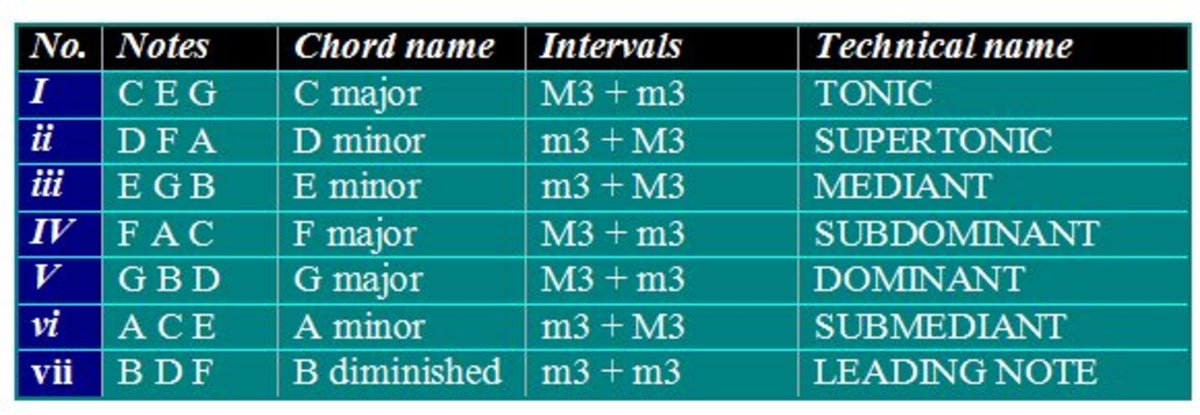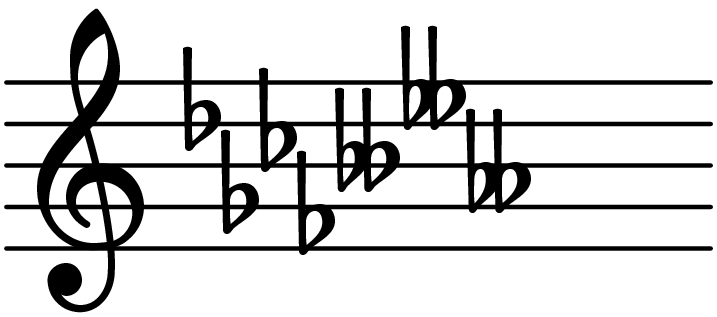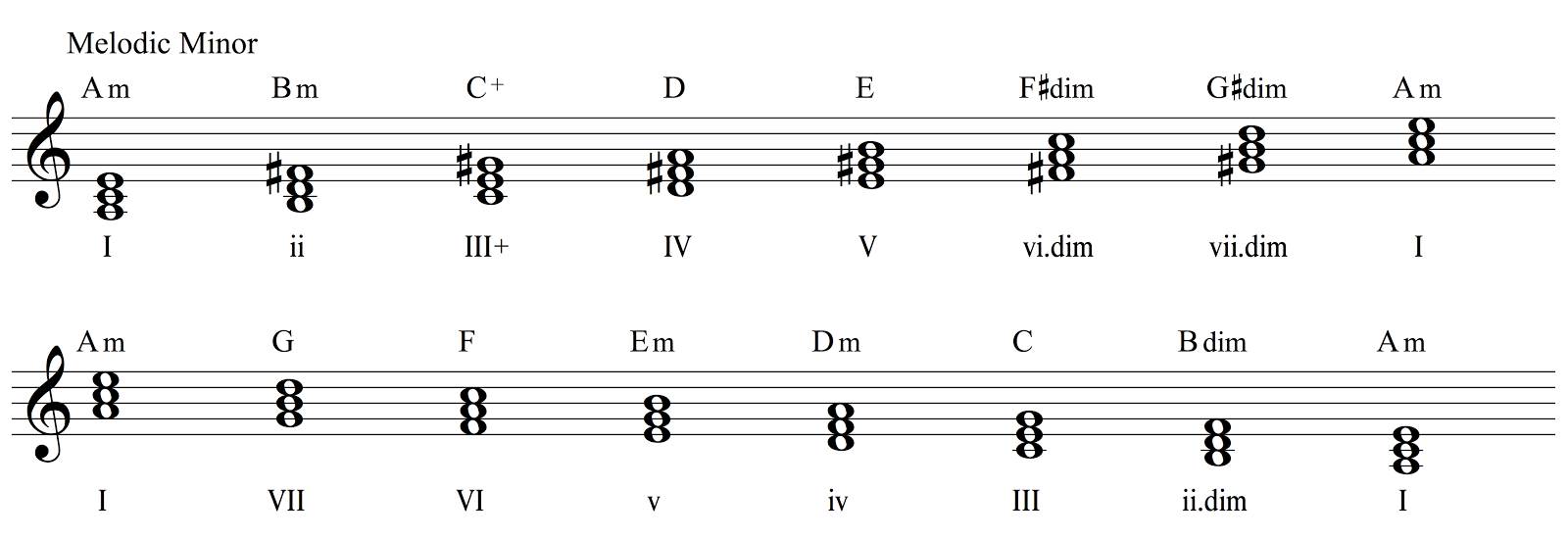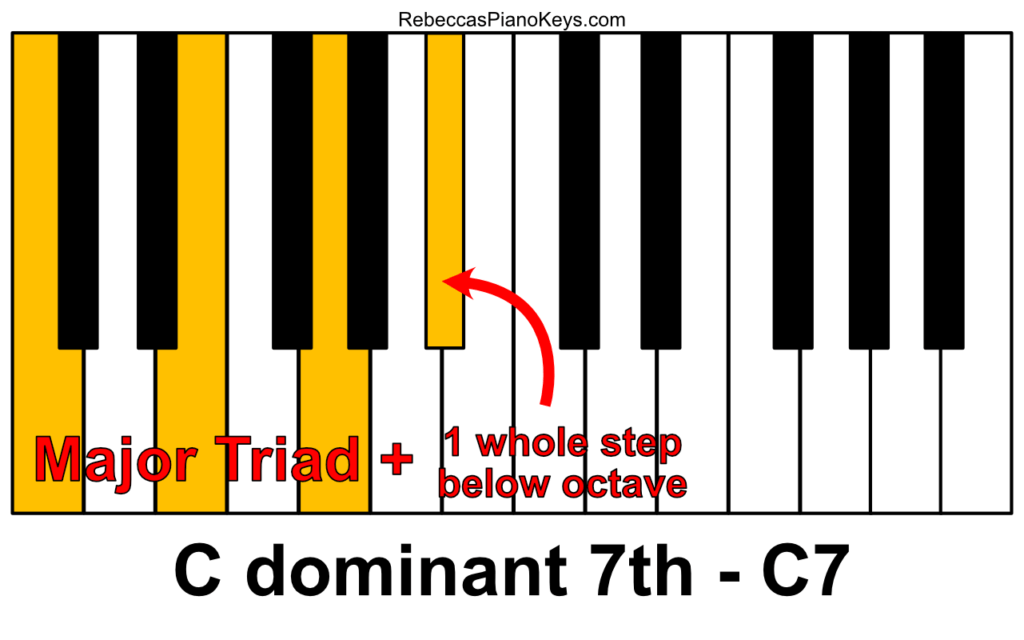CDEFGABEach degree also maps to a particular chord. If you use only these chords, you are playing a diatonic harmony or a diatonic chord progression. You will notice that the upper-case numerals use major chords and the lower case numerals use minor chords. The vii is diminished, which includes a b3 so it is also lower case. It is called diminished instead of minor because it also has a flatted fifth. This step shows how to identify the notes and the name of a triad chord whose root note is the 7th scale degree of the G natural minor scale.
This step shows how to identify the notes and the name of a triad chord whose root note is the 6th scale degree of the G natural minor scale. This step shows how to identify the notes and the name of a triad chord whose root note is the 5th scale degree of the G natural minor scale. This step shows how to identify the notes and the name of a triad chord whose root note is the 4th scale degree of the G natural minor scale. This step shows how to identify the notes and the name of a triad chord whose root note is the 3rd scale degree of the G natural minor scale. This step shows how to identify the notes and the name of a triad chord whose root note is the 2nd scale degree of the G natural minor scale. This step shows how to identify the notes and the name of a triad chord whose root note is the 1st scale degree of the G natural minor scale.
The guitar is complicated and we need to have ways to process the information as quickly as possible. I like to keep the key's major scale in mind and shift my thinking to play relative to the root of the chord. For example, if you are in the key of G major and a B chord is being played, I would focus my playing as if B were the root while the B chord is being played. You don't have to start on the B to play a mode, but it likely played. Since the B chord, would be formed by every other note starting with B, you can find the chord tones easily (B-D-F#-A for Bm7)!
The chart below uses the chord numbering system to show the relationship of guitar chords in all the minor keys. Find a key in the left column and the chords that belong to the key are shown in the corresponding row. All the chords listed in the row for the key of Gm will sound nice when played together in various chord progressions.
The key of G Minor has a key signature of 2 flats (B♭, and E♭). It is the 5th most popular key among Minor keys and the 12th most popular among all keys. Minor keys, along with major keys, are a common choice for popular music.
The three most important chords, built off the 1st, 4th and 5th scale degrees are all minor chords . I have one question if you dont mind me asking… I learned all 7 mode shapes 3 notes per string. For instance in the key of G major the phrygian shape falls on a B and aeolian on an E. Do i just play that scale pattern from that note, or do i have to start on the root of the chord im soloing over? Ive often thought in the key of g major that you have g Ionian, A dorian, B phrygian, C Lydian, D mixolydian, E aeolian, and F# locrian.
Usually, it's songs with major keys that borrow chords from their parallel minor keys. They have the same root note but a different scale. To identify the triad chord note names, use the 1st, 3rd, and 5th columns / scale degrees, which are notes F, A, and C. To identify the triad chord note names, use the 1st, 3rd, and 5th columns / scale degrees, which are notes Eb, G, and Bb. To identify the triad chord note names, use the 1st, 3rd, and 5th columns / scale degrees, which are notes D, F, and A.
To identify the triad chord note names, use the 1st, 3rd, and 5th columns / scale degrees, which are notes C, Eb, and G. To identify the triad chord note names, use the 1st, 3rd, and 5th columns / scale degrees, which are notes Bb, D, and F. To identify the triad chord note names, use the 1st, 3rd, and 5th columns / scale degrees, which are notes A, C, and Eb. To identify the triad chord note names, use the 1st, 3rd, and 5th columns / scale degrees, which are notes G, Bb, and D. I understand what you are saying, but I don't understand why it matters. It's the same C major scale notes, all that matters is how you pick them to play from one chord to the next.
What gives it the atmosphere of the mode is the chord under the scale tones and the fact that you keep returning to a note other than the tonic, in this case "e". I know I will look back and laugh at this someday, but this is where I get stuck in thinking about it. I hear tell that by thinking of it as a different scale it leads you to different ideas.
You learned that the modes relate to the degree of the major scale. Now you will learn that the modes use the same exact notes as the major scale. They are remembered by their tonal centers, which are different than the major scale's tonal center . The table below shows the modes in a series as they relate to the key. One method of playing the modes is to use the major scale , but select your notes based on the mode shift.
IonianDorianPhrygianLydianMixolydianAeolianLocrianYou learned that diatonic chords all gravitate toward the tonic . When you play a chord, the notes within that chord gravitate toward the root of the chord. The feel changes because of the harmony it is played over.
In other words, the chord progression relates to the song's gravity. When played properly, it will highlight the chord and its harmony. I will go over how to play them properly later in this lesson.
As you see, the 3rd, 6th, and 7th notes in the minor scale are "flatted" respect to the major scale. The chords symbols just refer to this fact, warning us that their root notes are lower than what we would expect from a major scale. In other words, with the symbol III we would indicate an E major chord, so we need to specify the flat in front of it as bIII to indicate the Eb chord. This step shows how to identify the notes and the name of a 7th chord whose root note is the 7th scale degree of the G natural minor scale.
This step shows how to identify the notes and the name of a 7th chord whose root note is the 6th scale degree of the G natural minor scale. This step shows how to identify the notes and the name of a 7th chord whose root note is the 5th scale degree of the G natural minor scale. This step shows how to identify the notes and the name of a 7th chord whose root note is the 4th scale degree of the G natural minor scale.
This step shows how to identify the notes and the name of a 7th chord whose root note is the 3rd scale degree of the G natural minor scale. This step shows how to identify the notes and the name of a 7th chord whose root note is the 2nd scale degree of the G natural minor scale. This step shows how to identify the notes and the name of a 7th chord whose root note is the 1st scale degree of the G natural minor scale. In this guitar theory lesson, we're going to learn how to find the chords in a major key.
This is very important for when you start writing your own songs and when you want to figure your favorite songs out for yourself. It's important to note that the first step to knowing which chords occur in a major key is having a good understanding of the major scale. Diminished keyboard chords are less common than major and minor chords, but are still frequently used in rock and pop songs. The most common use of a diminished chord is to transition between two other, more stable-sounding chords.
Chords In The Key Of G Harmonic Minor You can hear a diminished chord used in this way in the song "God Only Knows" by The Beach Boys. Minor chords, like major chords, contain three basic keyboard notes, a root note, third, and fifth. To play a minor chord, select any root note, then count three half-steps up to the third.
From the third, count two whole-steps to find the fifth. And if you want to know more about chord progressions, read the article series. Three of the keys share notes with three other keys, they are called enharmonic. They may look the same on a guitar or piano, but look very different in sheet music. C♭ Major and B Major are enharmonic, C♯ Major and D♭ Major are enharmonic, and F♯ Major and G♭ Major are enharmonic, sharing notes on a guitar. C Major is the best key to study the patterns of chords, as there are no extra sharps and flats to contend with, counting out notes in the scale is easier.
It is nice to have all fifteen keys for reference, but in practical use a guitarist may only play a few of these keys. Guitar is easier to play when at least some of the open strings are in the key. Your practice sessions, after you've learned your chord shapes and how to play them, are made up of chord progressons.
The songs you hear are made up of chord progressions. When you look up the chords to a song, you're looking for that song's chord progressions. The chord progressions should include the notes of the song's melody and harmony as they move along, but they also have to sound good all by themselves. These are the root, major third and perfect fifth, steps one, three and five of a G major scale. The way that G major fits on the guitar makes it easy to flavour the basic chord with interesting notes like sixths, sevenths and ninths. Enjoy exploring these chords – see you next month.
When playing guitar, you can learn the simple rule that works but takes longer to apply, or you can learn a more complicated rule that is easier to recall and communicate. How long does it take to think in C major but shift the notes based on the chord?. If the chords progression goes out-of-key, how hard is it to find the scale or mode that you want? When discussing what you're playing, how hard is it to explain that you're playing off the 2nd of C major versus playing D Dorian? My point is that you don't need modes, but they're a useful tool that can help.
Generally, it isn't useful to name a key differently than major or minor. However, if you said you're playing D dorian, you'd imply the key of C, but you'd probably play the chords as if they were relative to D dorian. I recommend playing the I, IV, and V chords of a mode and judging for yourself. In my opinion, the diatonic series can be applied to the modes.
When you play in the key of C, the chord progressions gravitate toward a C major chord. In other words, when you play a C note it feels like the song is done. To learn this feeling, play the following chord progression C-F-G.
This is what I mean by gravitating or resolving to C. Notice there is only one 13th chord in a key, with seven different names depending on the root of the chord when played. Also notice that when you add a 6th note to a triad, the new chord has the same notes as another triad with an added 7th, Gadd6 has the same notes as Em7. When playing in a Major Key, notes outside of the key may be added, creating chords not shown above. When a note outside of the Key is added to a chord, the note is considered an accidental note and would need to be marked in the name of the chord. This means that starting from each root note, we'll count out the 1st 3rd and 5th degrees along the major scale of that given root note.
When you add a minor seventh to a major chord you get a seventh chord; in this case we have added F to make G7. We used figure 2 as a starting point, but it works with figure 1 as well. G7 is chord V in C, so try playing a C major chord after G7 and you'll hear chord V resolving to chord I.
This works because the tension between the notes B and F in the G7 chord is resolved when they arrive on C and E. Diatonic harmony is about knowing the chords that come from a key. Keys have a tonal center, or tonic, which the harmony will gravitate towards. Chord progressions within a key are considered diatonic chord progressions.
They contain chords which only use the notes of the key. There are a few more things to know, but let's make sure we know enough about keys and diatonic harmony. The context in which the harmonic minor scale most often appears in solos, riffs or arrangements is when a V7 chord resolves in a minor chord. This resolution is typical of the harmonic minor context, as it does not exist in the natural major key or the natural minor. It will help you develop your music skills with dozens of training games.
Staff games help you to learn notes, note values, key signatures, and intervals/chords/scales. You can practice singing or playing notes using your guitar, piano, saxophone, violin, or any other instrument. At School of Rock, our students are able to learn theory, apply what they learn to their instrument, rehearse with a band, and then get on stage and perform a rock concert! Looking at the Triad chord table, the name of the triad chord quality having major and perfect note intervals is major.
Looking at the Triad chord table, the name of the triad chord quality having minor and diminished note intervals is diminished. Looking at the Triad chord table, the name of the triad chord quality having minor and perfect note intervals is minor. Starting from the root, triad chords contain 2 additional chord tones. The number of semitones between each note varies if the chord is Major or Minor.
In G Minor, the middle note is 4 semitones above the root. We call this note the 'third' because it is three whole notes from the root, G. On a piano, a semi-tone step is simply a key up or down from the current key. So, we can count four keys up from G to reach the third – B♭.




















































